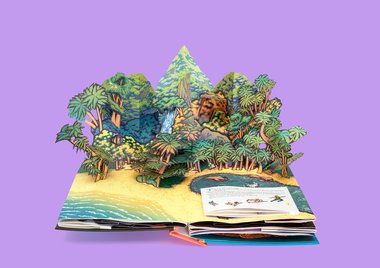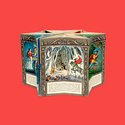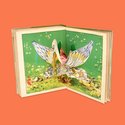John Hurrell – 4 January, 2019
As sculptures they are temporary, normally briefly standing vertical to be admired before the double-page spread is then re-closed. Opening and shutting these pages—admiring the expanding and compressing interactive component; the movement; the changing dimensions of the different directional vectors—is a muscular and ocular pleasure in itself.
Auckland
Books from Sir George Grey Special Collections
Playful: Pop-up Books
Curated by Zoë Colling
12 December 2018 - 3 March 2019
With a selection of books that open up to present folded (but now standing) paper sculpture, the Sir Grey Special Collections showcases some unusual acquisitions in the gallery on the public library’s second level. Over two dozen pop-up books are displayed in eight horizonal vitrines and two vertical glass cases. On the surrounding walls are enlarged photographs of some: nine colourful wall posters (some shown here) and twenty-four circular blow ups of details. All to remind you to look closely.
Nearby, on three low tables (with chairs) are also nine pop-up books adults and children can explore together: intricate and delicate constructions, each connected to some fairy-tale or rhyme. One minute they are closed, flat and not detectable; the next they appear open, sprouting from their centres three dimensional illustrations depicting some dramatic event in the book’s narrative.
The stories they tell—or scenes they describe—often from popular classics such as The Thousand and One Nights, Alice in Wonderland, The Bible, The Brothers Grimm, Cinderella, Beauty and the Beast, Pinocchio, Peter Pan, and Snow White, are treated with real panache. Some producers of particularly vibrant illustrations (like Robert Sabuda, Jan Pieńkowski and Vojtěch Kobašta) have several examples, and almost all work with brilliant paper engineers (like Rodger Smith and Helen Balmer), the genius designers who understand the properties of cut paper and how to make its planes change direction.
As sculptures they are temporary, normally briefly standing vertical to be admired before the double-page spread is then re-closed. Opening and shutting these pages—admiring the expanding and compressing interactive component; the movement; the changing dimensions of the different directional vectors—is a muscular and ocular pleasure in itself.
There is quite a range in this show. New Zealand artist Judy Millar is included on the tables, and there are some Victorian parlour entertainments as well in the vitrines. The pop-up genre is expanded to include a concertina ‘tunnel’ peepshow work where small screens with increasingly larger sized apertures are lined up like props on a stage. Another is a shallow box where windows and doors of a drawn house can be opened by levering fingers. The multisided ‘carousel’ works are also particularly impressive.
Playful extends over a very wide spectrum, from ‘simple’ uncoloured works that exploit shadow on form, plane and edge, to mind-bogglingly complex constructions that could almost be mini Frank Stellas, they are so richly complicated with interwoven elements. The selection incorporates many aspects of popular culture and science, from Star Wars and Asterix comics to Jonah in the Bible and the petal and stamen structure of flowers. Some are image-laden—others are very abstract; playing on distorted grids.
Although designed for children—with low ‘tag’ labels on the vitrines, steps so they can get a decent look, and dressing up costumes available in a pirate’s chest to excite their imaginations—only the most foolish of adults would ignore this very enjoyable and informative presentation. Note though, it shuts at five on weekdays, and four over the weekend.
John Hurrell




 Advertising in this column
Advertising in this column Two Rooms presents a program of residencies and projects
Two Rooms presents a program of residencies and projects



This Discussion has 0 comments.
Comment
Participate
Register to Participate.
Sign in
Sign in to an existing account.